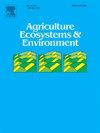Land use and temperature shape the beta diversity of soil nematodes across the Mollisol zone in northeast China
Abstract
Understanding soil biodiversity response to land use change is crucial for predicting and preserving soil ecological functions and health under anthropogenic influence. Yet, the overall effect of land use changes and climate conditions on belowground biodiversity remains insufficiently explored at large scales. Here, we studied the effect of conversion from natural soils to agricultural soils on soil nematode diversity and community assembly across the Mollisol zone in northeast China. We found that nematode alpha diversity decreased in agricultural soils, and nematode alpha diversity did not exhibit a regular change with latitudinal variation. For beta diversity, we found that nematode community structures were significantly affected by land use change. Furthermore, climatic factors and geographic distance significantly impacted the beta diversity of soil nematodes, but not the alpha diversity. Mean annual temperature was a primary climatic determinant of soil nematode communities, while the effect of mean annual precipitation on soil nematode beta diversity was only observed in agricultural soils. Stochastic processes dominated soil nematode community assembly, but agricultural soils increased the importance of deterministic processes compared to natural soils. There is no any expected variation in soil nematode alpha diversity along the Mollisol zone. Our findings highlight the crucial role of temperature in driving soil nematode communities.

 求助内容:
求助内容: 应助结果提醒方式:
应助结果提醒方式:


